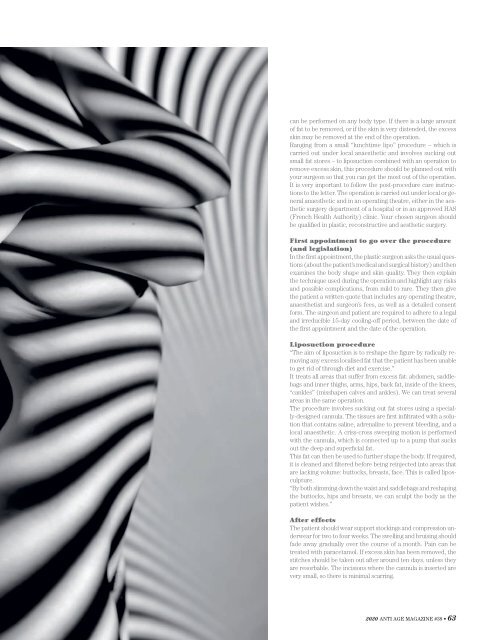ANTI-AGE #38
You also want an ePaper? Increase the reach of your titles
YUMPU automatically turns print PDFs into web optimized ePapers that Google loves.
can be performed on any body type. If there is a large amount<br />
of fat to be removed, or if the skin is very distended, the excess<br />
skin may be removed at the end of the operation.<br />
Ranging from a small “lunchtime lipo” procedure – which is<br />
carried out under local anaesthetic and involves sucking out<br />
small fat stores – to liposuction combined with an operation to<br />
remove excess skin, this procedure should be planned out with<br />
your surgeon so that you can get the most out of the operation.<br />
It is very important to follow the post-procedure care instructions<br />
to the letter. The operation is carried out under local or general<br />
anaesthetic and in an operating theatre, either in the aesthetic<br />
surgery department of a hospital or in an approved HAS<br />
(French Health Authority) clinic. Your chosen surgeon should<br />
be qualified in plastic, reconstructive and aesthetic surgery.<br />
First appointment to go over the procedure<br />
(and legislation)<br />
In the first appointment, the plastic surgeon asks the usual questions<br />
(about the patient’s medical and surgical history) and then<br />
examines the body shape and skin quality. They then explain<br />
the technique used during the operation and highlight any risks<br />
and possible complications, from mild to rare. They then give<br />
the patient a written quote that includes any operating theatre,<br />
anaesthetist and surgeon’s fees, as well as a detailed consent<br />
form. The surgeon and patient are required to adhere to a legal<br />
and irreducible 15-day cooling-off period, between the date of<br />
the first appointment and the date of the operation.<br />
Liposuction procedure<br />
“The aim of liposuction is to reshape the figure by radically removing<br />
any excess localised fat that the patient has been unable<br />
to get rid of through diet and exercise.”<br />
It treats all areas that suffer from excess fat: abdomen, saddlebags<br />
and inner thighs, arms, hips, back fat, inside of the knees,<br />
“cankles” (misshapen calves and ankles). We can treat several<br />
areas in the same operation.<br />
The procedure involves sucking out fat stores using a specially-designed<br />
cannula. The tissues are first infiltrated with a solution<br />
that contains saline, adrenaline to prevent bleeding, and a<br />
local anaesthetic. A criss-cross sweeping motion is performed<br />
with the cannula, which is connected up to a pump that sucks<br />
out the deep and superficial fat.<br />
This fat can then be used to further shape the body. If required,<br />
it is cleaned and filtered before being reinjected into areas that<br />
are lacking volume: buttocks, breasts, face. This is called liposculpture.<br />
“By both slimming down the waist and saddlebags and reshaping<br />
the buttocks, hips and breasts, we can sculpt the body as the<br />
patient wishes.”<br />
After effects<br />
The patient should wear support stockings and compression underwear<br />
for two to four weeks. The swelling and bruising should<br />
fade away gradually over the course of a month. Pain can be<br />
treated with paracetamol. If excess skin has been removed, the<br />
stitches should be taken out after around ten days, unless they<br />
are resorbable. The incisions where the cannula is inserted are<br />
very small, so there is minimal scarring.<br />
2020 <strong>ANTI</strong> <strong>AGE</strong> MAGAZINE <strong>#38</strong> • 63

















